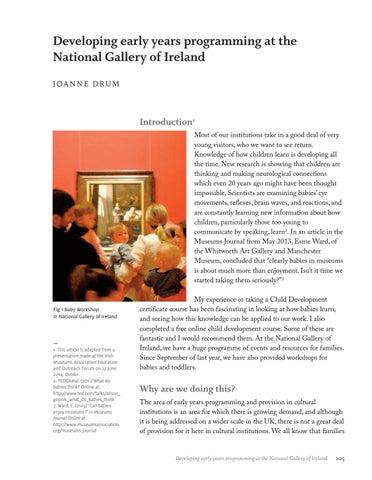Developing early years programming at the National Gallery of Ireland JOANNE DRUM
Introduction1 Most of our institutions take in a good deal of very young visitors, who we want to see return. knowledge of how children learn is developing all the time. New research is showing that children are thinking and making neurological connections which even 20 years ago might have been thought impossible. Scientists are examining babies’ eye movements, reflexes, brain waves, and reactions, and are constantly learning new information about how children, particularly those too young to communicate by speaking, learn2. In an article in the Museums journal from May 2013, Esme Ward, of the Whitworth Art Gallery and Manchester Museum, concluded that “clearly babies in museums is about much more than enjoyment. Isn’t it time we started taking them seriously?”3
Fig 1 Baby Workshop © National Gallery of Ireland
— 1. This article is adapted from a presentation made at the Irish Museums Association Education and Outreach Forum on 27 June 2014, Dublin 2. TEDGlobal. (2011)’What do babies think? Online at: http://www.ted.com/talks/alison_ gopnik_what_do_babies_think 3. Ward, E. (2013) ‘Can babies enjoy museums?’ in Museums Journal Online at: http://www.museumsassociation. org/museums-journal
My experience in taking a Child Development certificate course has been fascinating in looking at how babies learn, and seeing how this knowledge can be applied to our work. I also completed a free online child development course. Some of these are fantastic and I would recommend them. At the National Gallery of Ireland, we have a huge programme of events and resources for families. Since September of last year, we have also provided workshops for babies and toddlers.
Why are we doing this? The area of early years programming and provision in cultural institutions is an area for which there is growing demand, and although it is being addressed on a wider scale in the uk, there is not a great deal of provision for it here in cultural institutions. We all know that families
Developing early years programming at the National Gallery of Ireland
105













